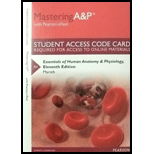
MasteringA&P with Pearson eText -- Standalone Access Card -- for Essentials of Human Anatomy & Physiology (11th Edition)
11th Edition
ISBN: 9780321957115
Author: Marieb
Publisher: Pearson College Div
expand_more
expand_more
format_list_bulleted
Concept explainers
Textbook Question
Chapter 1, Problem 2MC

Which of the following is (are) involved in maintaining homeostasis?
a. Effector
c. Receptor
e. Lack of change
b. Control center
d. Feedback
Expert Solution & Answer
Want to see the full answer?
Check out a sample textbook solution
Students have asked these similar questions
What is the difference between Uniporters, Symporters and Antiporters? Which of these are examples of active transport?
What are coupled transporters?
What are “domains” and how do they aid in protein function?
Chapter 1 Solutions
MasteringA&P with Pearson eText -- Standalone Access Card -- for Essentials of Human Anatomy & Physiology (11th Edition)
Ch. 1 - Prob. 1MCCh. 1 - Which of the following is (are) involved in...Ch. 1 - More than one choice may apply. Which of the...Ch. 1 - More than one choice may apply. Using the terms...Ch. 1 - Match the proper anatomical term (column B) with...Ch. 1 - Prob. 6MCCh. 1 - A neurosurgeon orders a spinal tap for a patient....Ch. 1 - More than one choice may apply. Which of the...Ch. 1 - Define anatomy and physiology.Ch. 1 - List the 11 organ systems of the body, briefly...
Ch. 1 - Prob. 11SAECh. 1 - Explain the difference between positive and...Ch. 1 - Many body structures are symmetrical. Are the...Ch. 1 - Describe the locations that the following body...Ch. 1 - Which of the following organ systems-digestive,...Ch. 1 - A diagnostic radiographer told John that she was...Ch. 1 - 23. How is the concept of homeostasis (or its...Ch. 1 - Jennifer fell off her motorcycle and tore a nerve...Ch. 1 - Mr. Garica is behaving abnormally and doctors...Ch. 1 - 19. Parathyroid hormone (PTH) is secreted in...Ch. 1 - 20. Mr. Harvey, a computer programmer, has been...
Knowledge Booster
Learn more about
Need a deep-dive on the concept behind this application? Look no further. Learn more about this topic, biology and related others by exploring similar questions and additional content below.Similar questions
- What are intrinsically disordered proteins, and how might they be useful for a living system?arrow_forwardWhat are Amyloid Fibrils? What biological functions are these known to perform?arrow_forwardHow do histamine and prostaglandins help in the mobilization of leukocytes to an injury site? What are chemotactic factors? How do they affect inflammation process?arrow_forward
- Compare and contrast neutrophils and macrophages. Describe two ways they are different and two ways they are similar.arrow_forwardDescribe the effects of three cytokines (not involved in the initial inflammation response). What cells release them?arrow_forwardDescribe activation of helper T cells or cytotoxic T cellsarrow_forward
- Compare and contrast MHC 1 and MHC 2. Describe two way they are different and two ways they similar including how they are used in antigen presentation.arrow_forwardDescribe two antimicrobial properties of the skin.arrow_forwardDescribe how the inflammation response starts including the sentinel cells and the chemicals involved. How do pathogens trigger the response particularly in the skin?arrow_forward
- How does complement promote the immune response? Describe three waysarrow_forwardWhich of the following is not a possible mechanism for autoimmunity? Select one: A. Abnormal expression of MHC II molecules in non-antigen-presenting cells B. Activation of polyclonal B cells C. Polymorphism of HLA alleles D. Molecular mimicry E. Release of sequestered antigensarrow_forwardWRITTEN WORK 3: NON-MENDELIAN GENETICS Part A: Complete the Punnett square and calculate for the probability of genotype and phenotype. i i Genotype: Phenotype: 08:55arrow_forward
arrow_back_ios
SEE MORE QUESTIONS
arrow_forward_ios
Recommended textbooks for you
 Comprehensive Medical Assisting: Administrative a...NursingISBN:9781305964792Author:Wilburta Q. Lindh, Carol D. Tamparo, Barbara M. Dahl, Julie Morris, Cindy CorreaPublisher:Cengage Learning
Comprehensive Medical Assisting: Administrative a...NursingISBN:9781305964792Author:Wilburta Q. Lindh, Carol D. Tamparo, Barbara M. Dahl, Julie Morris, Cindy CorreaPublisher:Cengage Learning

Comprehensive Medical Assisting: Administrative a...
Nursing
ISBN:9781305964792
Author:Wilburta Q. Lindh, Carol D. Tamparo, Barbara M. Dahl, Julie Morris, Cindy Correa
Publisher:Cengage Learning


What is Homeostasis? | Physiology | Biology | FuseSchool; Author: FuseSchool - Global Education;https://www.youtube.com/watch?v=quQr6X1Q58I;License: CC-BY